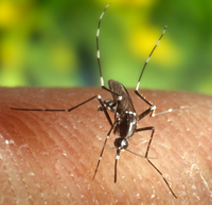| Human medicine.
This section of the CIR comprises research within the human medical area of environmental medicine concerning the relationship between disease and climate. The records are categorized according to especially relevant disease or climatic factors. The following factors of disease associated with climate impacts are taken into account: thermal load, viral or bacterial infection, allergenic, carcinogenic and toxic reaction. As for climate impacts associated with disease factors, the following are taken into account: weather, animal and plant phenology, land use, atmosphere. Based on this categorization the following key topics regarding the relationship between disease and climate can be defined: heat stress (e.g. disorders of the circulation and of water and electrolyte balance) and its link to weather (heat waves) and land use (urban climate); viral or bacterial infections (e.g. influenza, Lyme disease, meningoencephalitis, malaria) and their link to weather (influenza epidemics) and animal phenology (certain species of ticks, mosquitoes and birds as vectors of viruses and bacteria); allergenic and carcinogenic reactions (e.g. asthma, rhinitis, UV erythema, skin and lung cancer) and their link to weather (production of smog along with ozone and particulate pollution, sunshine duration and corresponding exposure to UV radiation), land use (urban climate), plant phenology (occurrence of pollen, e.g. Ambrosia), and atmosphere (ozone layer and UV radiation intensity). Some of the aforementioned key topics have hardly been the subject of historical or regional research. Special attention is therefore paid to the inclusion of recent and supra-regional research in the CIR.
⇐ back
|




